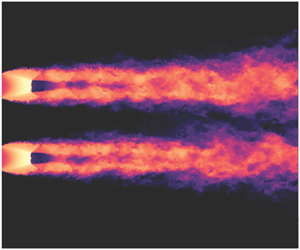Article contents
Intermittent modal coupling in screeching underexpanded circular twin jets
Published online by Cambridge University Press: 11 January 2021
Abstract

In this article the erratic coupling that can occur in screeching supersonic twin jets is characterised. Non-stationary acoustic analysis is used to investigate the temporal behaviour of the coupling phenomena. The results show that where the phase between the jets is time varying, the screech tone experiences interruptions. The interruptions are either correlated and experienced by both jets or are anti-correlated and only by one. During the anti-correlated interruption, the uninterrupted jet screeches as an isolated jet. The instantaneous velocity field shows that for the majority of snapshots during an acoustic interruption, the jets do not exhibit a coupled oscillation. When the jets are uninterrupted, they are oscillating in either a coupled symmetric or anti-symmetric mode. This behaviour manifests at a condition between two operating points characterised by different coupling modes. It suggests the interruptions arise due to a competition between two global modes of the flow. Despite the existence of multiple acoustic tones in the region where these modes are competing, analysis of the individual jets reveals energetic structures with only a single wavelength. It is found that jets whose own oscillation is characterised by a single wavelength can, through coupling either symmetrically or anti-symmetrically about their symmetry plane, produce different acoustic tones. These findings are consistent across three experimental facilities. The observed modes are a function of the jet spacing and nozzle pressure, therefore future studies investigating other spacings must recharacterise the encountered coupled modes. This article provides the signatures to characterise the behaviour for future studies.
JFM classification
Information
- Type
- JFM Papers
- Information
- Copyright
- © The Author(s), 2021. Published by Cambridge University Press
References
REFERENCES
Bell et al. supplementary movie 1
This video shows the proper orthogonal decomposition reconstruction of the velocity field. The dominant modes are used to provide phase information. The first twenty modes are used to add fluctuation information.
Bell et al. supplementary movie 2
This video shows time resolved coupling of supersonic twin jets using ultra high speed schlieren photography. Different nozzle pressure ratios are shown. In certain regions, the coupling is shown to be unsteady and interrupted via acoustic and particle image velocimetry. This video shows the this unsteadiness as a qualitative comparison.
- 18
- Cited by

